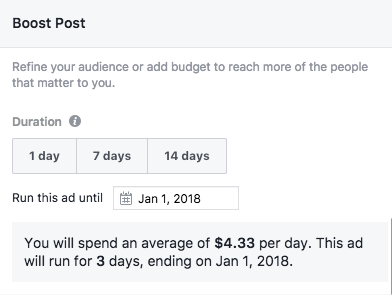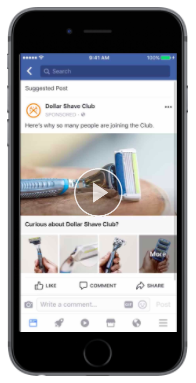As we dive head first into 2018, there are a few PPC questions we want to clarify that we get asked all the time. From Facebook ads to ad spend, many of you have common questions that deserve answers and you’re not alone! Since these topics keep coming up, we thought it would be a great idea to cover them on our blog. Here are the top 5 PPC questions we get asked everyday with the most thorough answers we can provide. Enjoy! But don’t hesitate to reach out to our managed services team if ever you have more questions on these topics or any others – we’re here to help.
1 Why Buy Facebook Ads Over Boosting a Post?
This is a very logical question that social media advertisers face on the regular and the answer takes a bit of explanation.
Anyone managing a brand’s Facebook page has seen the automatic prompts to boost a post. These prompts appear and remain at the bottom of updates added to a company’s feed as shown in the image below:
Boosting a post allows brands using Facebook to put their status update in front of more people than simply sharing on their wall would. Boosting allows advertisers to have their update appear on the desktop or mobile newsfeed, to choose from one of two objectives (website visits or engagements), to define an audience based on geography, age or their relationship with your page (has liked it or is friends with someone who liked it), and to determine a budget in a currency of their choice over the course of 1, 7 or 14 days of promotion. Once these parameters are set by the brand, Facebook will show the estimated reach and spend per day.
All of these option s available to advertisers when boosting a particular post are a lot like when a true Facebook ad is created. So what’s the difference? And why would anyone bother creating a Facebook ad when they could just boost a post?
s available to advertisers when boosting a particular post are a lot like when a true Facebook ad is created. So what’s the difference? And why would anyone bother creating a Facebook ad when they could just boost a post?
The main reason is that advertisers can access many more options through Facebook ads than they could by boosting or promoting a post. When advertisers create a Facebook ad they can choose various ad formats, placements, select more goals or marketing objectives and access many more options for ad targeting. To elaborate more on the additional possibilities that running Facebook ads provides, lets drill down into each of these.
Facebook Ad Formats
Consider that brands can run an ad campaign with a photo, a video, a carousel of images, a slideshow or even a collection of products featured in one campaign when they use Facebook ads. Yes, a brand could create an image for a post that features many different products for example, but it wouldn’t have the same functionality of an ad featuring a collection. The image below demonstrates the Collection format of a Facebook ad where users can click on different products in a more engaging format than if it were just a boosted static image that led to one product page or another.
Facebook Placements
Advertisers can also place ads in different ad space around the Facebook ecosystem, whereas with a boosted post the only option is to show up in the mobile or desktop newsfeed. Facebook ad placements include inside newsfeeds (like with boosted posts), inside Facebook groups, in the right column of feeds (aka right-hand-rail), within Instant articles on the mobile app or messenger or within in-stream videos. Since Facebook owns Instagram, advertisers can also access this entirely other channel through Facebook ads, but that’s another story on its own.
Advertisers need to test which ad placement gets them the best results. For example, Lee Goldberg said in our Guide to Facebook Advertising Success that in his experience right column ads tend to get low click volume but have a high conversion rate. If the advertiser’s goal is to generate website conversions with a low budget, a Facebook ad campaign with right column placements may be the best fit – but again, always be testin!
Facebook Ad Goals
While we mentioned above that boosted posts allow brands to choose between the marketing objective of getting either website visits or engagements, Facebook ads allow for more types of objectives or goals. Brands running Facebook ads can create a campaign to get them attendees at an event, to generate video views, to incite app installs, to get likes for their brand’s Facebook page and of course for post engagement, and website clicks and website conversions. If the brand’s main goal was to get people to download their app, an ad campaign focusing on downloads as the end objective would be a more suitable option than simply boosting a post.
Facebook Ad Targeting
While boosting a Facebook post provides some targeting options for advertisers and brands like geography and age, Facebook ads have more advanced possibilities. Facebook ads allow advertisers to target by age, location, demographic, interests, behavior, device-type and even using custom lists from email marketing campaigns.
And with all of these additional capabilities, advertisers have a better chance of generating better campaign results and returns than if they had just boosted a post. Some brands may simply want to reach more people with an important news announcement rather than creating a whole ad campaign, and in this case boosting a post may be more appropriate. Otherwise Facebook ads is likely a better choice.
2 Why Can’t I See My Ad When I Google My Company Name?
The first thing we always tell clients is not to search for themselves because it creates false impressions and can temper campaign results. However, to answer the question, anyone running search ads knows that their ads appear in SERPs based on keywords selected by the advertiser in AdWords, Bing or another search engine. That means if the advertiser has not included their own company name or brand as a keyword in one of their ad groups, their ad will not show when anyone searches for their brand inside a search engine. In that case, brands can only hope that their website appears in the organic search results near the top of the page under the ad section. It is for this reason that we have been telling advertisers for some time to remember to create branded campaigns:
“When it comes to bidding on keywords, we can’t forget our own company identity. Don’t forget to bid on brand terms. Avery labels decreased their campaign costs by 51% by buying their own branded keywords. This also raised the cost of these keywords and stopped their competitors from bidding on them. PPC campaigns that bid intelligently on brand name keywords do better than those that don’t.”
If your brand doesn’t appear when you search for it, it’s because you haven’t included your own brand in your ad campaigns. Creating a branded ad group or simply adding branded keywords to existing campaigns will fix that instantly.
However, if you have created a branded ad group and you’re still not seeing your ad, there could be a few reasons why it isn’t showing including daily budget, the geographical target set, IP address and more. RevLocal elaborates a bit more about why certain ads don’t show in SERPs.
3 What is the Ideal Budget I Should Allocate for Adwords or Facebook?
This is certainly the million dollar question and the age old answer is that it depends. Unfortunately, there is no magic number to this question that can apply to all individual situations and ultimately it depends on how much budget an advertiser has to allocate to either channel in the first place. It also depends on your audience and campaign goals. Does your audience spend time on Facebook or are they more likely to convert through a search ad campaign?
If both channels are indeed an appropriate choice for your advertising goals and you just want to divide your budget between each, you could start off with an even split and see which channel performs best. If your ad campaign goal is to generate website conversions and you’re seeing more conversions come from Facebook than search for example, you may want to increase your budget in this channel incrementally until you find the right balance.
The problem is that both the search and social advertising ecosystems are dynamic and the results are subject to even more factors than an advertiser’s individual goals and circumstances. For example, one channel may perform better now than in 2 months as a result of seasonality. Due to the ongoing complexities of this dilemma that advertisers face, Acquisio developed a new AI algorithm that will distribute budget where it will perform best everyday. Anyone using the Acquisio platform can turn on this new algorithm and never have to think of this question again, while still getting optimal results.
4 How do Keywords Work and What Should I Pay for a Specific Keyword?
In general, keywords tell search engines which words you would like your ad to appear for. Advertisers should figure out how to select the best keywords for their campaign before deciding on which and what to bid on.
Determining what advertisers should pay for a specific keyword is another “it depends” type of question. First of all, in search ads advertisers bid on specific keywords, which is different from what they end up paying in the end for each, otherwise known as their cost-per-click (CPC). So what anyone should pay for a specific keyword isn’t the right question to ask, rather they should ask, ‘what should I bid?’.
Bidding can be complex and is again why Acquisio has developed 30 different AI algorithms for bid and budget management. Prices per keyword vary depending on how many people are bidding on the same keyword and how much they’re bidding, yet it’s almost impossible for advertisers to have this competitive data. Publishers like AdWords provide a suggested bid, but it doesn’t guarantee results. In fact, bids need to be modified throughout the day according to ongoing fluctuations in the auction to generate optimal results. From this respect, determining the answer to what to bid per keyword becomes a full time job.
To know what to bid at a keyword level, advertisers have to understand how the auction works and modify bids accordingly. The bid given by the advertiser determines what position they will show up in within ad results embedded in SERPs for various keywords. If the bid isn’t high enough for a particular keyword, they won’t show up at all as we explained in a past post on automation.
“An effective bid can be the difference between being the first ad to appear on search and not appearing on the page at all. An optimal bid is one that generates a higher return on investment (ROI). The best bids are those that cost less and generate more engagement. Manually figuring out the right bid at the ad group and keyword level requires a lot of work, analysis and time, and it’s not something campaign managers can realistically handle at scale.”
Again, the answer to this question is quite complex and yet so fundamental to PPC success. We recommend that anyone having difficulty answering this question for themselves, either hire a PPC expert or use Acquisio Turing for artificially intelligent bid and budget management.
5 What’s my Position Compared to my Competitors?
If you’re an advertiser and you want to know where your ad stands compared to your competitors, you can simply open up an incognito window in your browser and type in the keyword you’re looking to shed light on. You’ll see your ad in relation to all of the competitors bidding on this keyword. However, as you know from previous answers above, your position for a particular keyword can vary throughout the day, week, month etc., as other variables like competitor bids and quality score in the auction fluctuate. In some circumstances your ad may not appear at all.
Looking at your ad rank and average position is a better overall indicator of where you stand. Checkout this AdWords Competition Guide to discover 4 tools that will help you figure out how your competitors are performing, like using the Auction Insights Report to determine their average position.
Image Credits
Feature Image: Unsplash/Climate KIC
Screenshots 1-2 by Sandra Jimenez. Taken December 2017 from Facebook.
Image 3: Screenshot by Sandra Jimenez. Taken December 2017 from Facebook Business.




